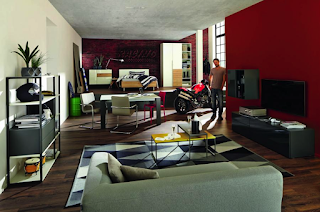Transitional kitchens blend modern and traditional styles, making them ideal for someone who wants to take the best aspects of both. Read our recent Transitional Kitchens article to learn more details.
 We’d like to explore transitional styles in the home, and how your kitchen can inspire such styles in the living room and beyond.
We’d like to explore transitional styles in the home, and how your kitchen can inspire such styles in the living room and beyond.
Transitional kitchens are somewhat contemporary without being too hard-edged. If you want this effect throughout the home, you can install storage cabinetry in a similar style throughout your home. For the living room, your furniture can act as a liaison between the kitchen and other areas of the home. If you are remodeling the bedroom, consider a dresser and possibly a wardrobe or walk in closet with details that are complimentary to the kitchen and living room cabinets also.
Cabinets are super practical for storage, and functionality is a feature of modern kitchens. To balance modern with traditional designs, your cabinetry should use clean lines and not too much ornamentation. Stick with a simple metal bar or knob handle and maybe a subtle shaker-style cabinet detail. This adds just the right amount of country style, while the overall look is still grounded and current.
 As for the rest of your furniture, such as tables and beds, this rule also applies. You can use a neutral color palette of browns and whites and and accent with a more bold color if desired. Transitional homes usually feature a mix of different materials for balance. This cottage style Nobilia kitchen is a great example. Its shaker style cabinets are finished in white, with a deep textured wood for the counter top. The nook in the back with hangers for the apron and tote bags works perfectly as a transition to the entry way or living room.
As for the rest of your furniture, such as tables and beds, this rule also applies. You can use a neutral color palette of browns and whites and and accent with a more bold color if desired. Transitional homes usually feature a mix of different materials for balance. This cottage style Nobilia kitchen is a great example. Its shaker style cabinets are finished in white, with a deep textured wood for the counter top. The nook in the back with hangers for the apron and tote bags works perfectly as a transition to the entry way or living room.
In the living room, your transitional cabinetry is typically used for sideboards and the entertainment center. Find a look that compliments your kitchen design. You can choose to go with handles or without, but make sure that if your cabinets lean toward modern, they are paired with a rustic finish like exposed brick or wood texture. The same rules go for the dining or coffee table, which should be fairly geometric and simple in design. You can really fine tune the details to what you like here - dress it up with something showy like a chandelier, or keep it contemporary with slim sofas and chairs.
 For the bedroom, your closet and dressers should also have modern style, but with traditional details worked in. Pairing wood with lacquer has a very nice calming effect, as seen in this studio apartment with Hulsta furniture in the sleep area. Because this is a one room studio, we can see the consistency of transitional details in this space. The bed and night stand also have clean geometric shape to them, mixing oak wood and white lacquer. The rounded knob handles are very minimal. This home’s overall effect is contemporary, yet warm, thanks to the homeyness of the oak and the exposed brick wall.
For the bedroom, your closet and dressers should also have modern style, but with traditional details worked in. Pairing wood with lacquer has a very nice calming effect, as seen in this studio apartment with Hulsta furniture in the sleep area. Because this is a one room studio, we can see the consistency of transitional details in this space. The bed and night stand also have clean geometric shape to them, mixing oak wood and white lacquer. The rounded knob handles are very minimal. This home’s overall effect is contemporary, yet warm, thanks to the homeyness of the oak and the exposed brick wall.
A transitional home gives so much design freedom, so this concept is perfect for a decorator with the desire to stay current with trends, but wants to add their own spin to their interior design. It takes guts to break through tried and true design themes that are accepted as the status quo. To speak with one of our designers about pulling off a transitional look throughout your home, consider a free consultation.



No comments:
Post a Comment